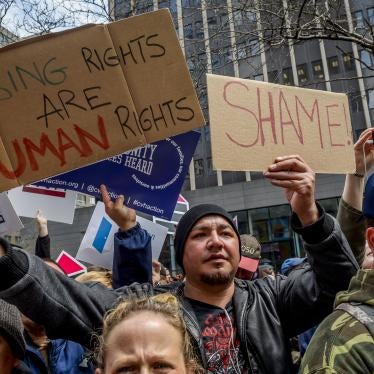Dear Chairman Brown, Ranking Member Toomey, Chairwoman Waters, and Ranking Member McHenry,
I write on behalf of Human Rights Watch to urge you to increase appropriations to public housing, under Section 9 of the US Housing Act, as part of the $339 billion allocated to housing programs under the recently passed budget resolution. We urge you to provide public housing authorities (PHAs) the funding they need to fully meet their repair needs and ensure safe, habitable housing.
Public housing is a critical resource for low-income people across the United States, especially women, those with disabilities, as well as Black, Indigenous, and other people of color. It is crucial to ensuring safe and affordable housing for all, as international human rights standards provide. Yet decades of devastating budget cuts have forced many public housing residents to live in homes made unsafe by lead paint, mold, and disrepair. Alternatives to Section 9, such as the Rental Assistance Demonstration (RAD), however, have reduced oversight and protections for residents, and in some cases we have examined in New York City, appear to have led to increased evictions.
No one should have to choose between housing that is unaffordable and housing that is uninhabitable. The recently approved $3.5 trillion budget resolution provides a unique opportunity to reinvest in public housing and protect the human rights of the over 1.8 million people who rely on this critical resource.
Public Housing is a Crucial Source of Affordable Housing
Because rents in public housing are capped at 30 percent of a household’s income, public housing is a critical source of affordable housing for low-income families. In New York City, for example, public housing comprises over half of the homes which are affordable to extremely low-income tenants, or those making less than 30 percent of the area median.[1] Human Rights Watch has been conducting research on public housing for a forthcoming report, and many residents we interviewed testified to the crucial role public housing has played in their own lives. One resident described how the affordability of public housing enabled her late-grandmother to retire. “There is no way she would have been able to have that quality of life at the end of her life without public housing,” she told Human Rights Watch.
Public housing is uniquely able to provide homes that are permanently affordable.[2] Affordability guarantees in other supply-side affordable housing programs, such as the Low-Income Housing Tax Credit (LIHTC) and project-based Section 8 housing, typically expire after a number of years. As a result, over 700,000 homes will see their affordability restrictions expire by 2029, placing thousands of families at risk of displacement.[3]
Budget Cuts Have Violated the Human Rights of Public Housing Residents
Because most public housing residents have low incomes, resident rents alone are insufficient to cover a PHA’s operating costs and maintenance needs. Subsidies are thus necessary to ensure that public housing is well-maintained. However, the main sources of federal funding, the public housing capital fund — which funds major repairs — and the public housing operating fund — which provides for day-to-day operation and maintenance — have long been insufficient.
In real terms, funding for public housing capital repairs was 35 percent lower in 2021 than it was in 2000.[4] Annual operating funding for public housing has consistently been insufficient to cover the gap between revenue from tenant rents and a PHA’s operating costs.[5]
As a result of this chronic underfunding, many public housing developments face spiraling repair needs, and many residents face serious problems with their homes. Each year, as many as 15,000 public housing apartments are closed or demolished because they are no longer habitable.[6] Decades of deferred maintenance has driven up the costs of bringing the public housing stock up to a state of good repair, which is now estimated at over $70 billion.[7]
The residents of public housing Human Rights Watch interviewed have testified to how their homes have deteriorated. They described going without heat during the winter, having walls covered in mold, and being exposed to lead paint. Insufficient operating support has left them waiting weeks or months for needed repairs. “Now, the waiting period [for repairs], it can’t even be calculated,” one resident said.
Despite the myriad problems they face, many residents Human Rights Watch interviewed still believed in the promise of public housing. “Public housing is not negotiable; the things we’ve been able to do in my family wouldn’t have been possible without it,” one resident told Human Rights Watch. “I’m still fighting to justify the fact that we deserve to have a place to live.”
Alternatives to Section 9, Such as the Rental Assistance Demonstration (RAD), Reduce Oversight and Protections for Residents’ Rights
Persistent underfunding has forced many PHAs to choose between allowing their housing to further deteriorate or utilizing new federal programs that remove housing from the Section 9 public housing program. One of these new programs, called the Rental Assistance Demonstration (RAD), has seen some PHAs transfer or lease their developments to private companies, in order to raise needed financing for repairs.
Human Rights Watch has a forthcoming report about the effects of RAD in New York City, and our research indicates that the program results in the loss of oversight, accountability, and support mechanisms that are important to protect residents’ human rights. Data provided to Human Rights Watch by the New York City Housing Authority (NYCHA) also indicates that some RAD-converted housing developments have seen an increase in their annual eviction rates. Evictions that leave individuals homeless or lead to other violations of human rights violate the human right to housing. Given the vulnerable population public housing serves, increases in evictions raise concerns over human rights.
It is also not clear that RAD has led to consistent improvements in the quality of housing. Several residents in RAD-converted developments in New York City reported ongoing issues with the habitability of their homes and with accessing crucial resources. According to one resident, “it feels like a lot of things that they promised they were going to fix were like half-way done.” Some residents described continuing to face issues with mold as well as potentially unsafe construction practices.[8] Some residents also described struggling to find support when they face issues. “I called my social worker [at NYCHA] and she told me that she had nothing to do anymore with this building, and that she could not help me,” one resident said. “Now I don’t have one; I don’t know who to call, or who to help me.”
While Human Rights Watch’s research on RAD has focused primarily on New York City, there are reports of similar issues with RAD conversions in other communities.[9]
For all these reasons, we urge the Senate Committee on Banking, Housing, and Urban Affairs, the House Committee on Financial Services, and all senators and representatives to provide sufficient funding, under Section 9 of the US Housing Act, to fully close the capital needs backlog of public housing. Doing so can ensure public housing residents benefit from affordable, habitable, and dignified homes for decades to come.
We would be happy to provide additional information and welcome the opportunity to further discuss this issue.
Sincerely,
Arvind Ganesan
Director, Business and Human Rights
Human Rights Watch
[1] New York University Furman Center, NYCHA’s Outsized Role in Housing New York’s Poorest Households, December 2018, https://furmancenter.org/files/NYCHA_Brief_12-17-18.pdf (accessed May 7, 2021), p.4.
[2] See generally Alex F. Schwartz, Housing Policy in the United States (Third Edition, New York: Routledge, 2015), p. 196. (“The secret to the longevity of public housing is its public ownership. Unlike virtually all other types of subsidized housing, public housing guarantees perpetual low-income occupancy. There are no subsidy contracts to renew and, unlike other project-based subsidy programs, owners do not have the option of eventually converting public housing to market-rate occupancy.”).
[3] See Public and Affordable Housing Research Corporation and the National Low Income Housing Coalition, 2020 Picture of Preservation, https://preservationdatabase.org/wp-content/uploads/2020/05/NHPD_2020Report.pdf (accessed August 27, 2021), p.13; see also Vincent J. Reina and Ben Winter, “Safety Net? The Use of Vouchers When a Place-Based Rental Subsidy Ends” Urban Studies 56(10): 2093 (2019) doi: 10.1177/0042098018782407; National Council of State Housing Agencies, Proposal to Prevent the Loss of Affordable Housing, June 10, 2019, https://www.ncsha.org/wp-content/uploads/Qualified-Contracts-Proposal-June-10.pdf (accessed August 30, 2021).
[4] Human Rights Watch Analysis of HUD Budget Justifications, Fiscal Years 2013-2022; Congressional Research Service (CRS), Introduction to Public Housing, February 13, 2014, https://crsreports.congress.gov/product/pdf/R/R41654/14 (accessed April 29, 2021), table 8, p. 38.
[5] Center on Budget and Policy Priorities, Congress Prioritizes Housing Programs in 2018 Funding Bill, Rejects Trump Administration Proposals, July 19, 2018, https://www.cbpp.org/sites/default/files/atoms/files/7-19-18hous.pdf (accessed July 14, 2021), pp. 6-7, figure 3; HUD, Explanation of 2019 Holdback Obligations, https://www.hud.gov/sites/dfiles/PIH/documents/ExplanationErrorholdbacK.pdf (accessed July 14, 2021).
[6] National Low Income Housing Coalition (NLIHC), Priorities for the American Jobs Plan, March 15, 2021, https://nlihc.org/sites/default/files/American_Recovery_Plan.pdf (accessed May 27, 2021), p. 2.
[7] National Association of Housing and Redevelopment Officials (NAHRO), Capital Fund Backlog, https://www.nahro.org/wp-content/uploads/2020/04/CAPITAL_FUND_BACKLOG_One-Pager.pdf (accessed July 15, 2021).
[8] See also Greg B. Smith, Manhattan Lead Paint Confusion Casts New Doubts on Moving Public Housing to Private Management, The City, August 22, 2021, https://www.thecity.nyc/2021/8/22/22636629/nycha-manhattan-lead-paint-public-housing-private-management (accessed August 27, 2021).
[9] See, e.g, Luke Broadwater, Tenants Evicted Improperly From Baltimore’s Privatized Public Housing, Complaint Alleges, The Baltimore Sun, February 8, 2018, https://www.baltimoresun.com/maryland/baltimore-city/bs-md-ci-public-housing-evictions-20180208-story.html (accessed August 27, 2021); Ginny Monk, Tenants Displeased Over U.S.-Funded Apartment Updates, Arkansas Democrat Gazette, November 13, 2020, https://www.arkansasonline.com/news/2020/nov/13/tenants-displeased-over-us-funded-apartment-update/?latest (accessed August 27, 2021); Danielle McLean, Trump’s HUD Wants to Expand Flawed Program That Is ‘Privatizing Public Housing,’ Think Progress, February 27, 2019, https://archive.thinkprogress.org/a-flawed-public-housing-program-leaves-vulnerable-residents-at-the-mercy-of-developers-66a0ee5b2321/ (accessed August 27, 2021).







